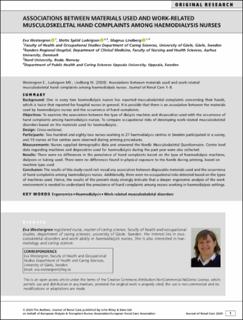| dc.contributor.author | Westergren, Eva | |
| dc.contributor.author | Ludvigsen, Mette Spliid | |
| dc.contributor.author | Lindberg, Magnus | |
| dc.date.accessioned | 2020-07-20T08:10:12Z | |
| dc.date.available | 2020-07-20T08:10:12Z | |
| dc.date.created | 2019-12-02T07:21:23Z | |
| dc.date.issued | 2020 | |
| dc.identifier.citation | Westergren, E., Ludvigsen, M. S. & Lindberg, M. (2020). Associations between materials used and work-related musculoskeletal hand complaints among haemodialysis nurses. Journal of Renal Care. doi: | en_US |
| dc.identifier.issn | 1755-6686 | |
| dc.identifier.uri | https://hdl.handle.net/11250/2669688 | |
| dc.description.abstract | Background
One in every two haemodialysis nurses has reported musculoskeletal complaints concerning their hands, which is twice that reported for hospital nurses in general. It is possible that there is an association between the materials used by haemodialysis nurses and the occurrence of hand complaints.
Objectives
To examine the association between the type of dialysis machine and disposables used with the occurrence of hand complaints among haemodialysis nurses. To compare occupational risks of developing work‐related musculoskeletal disorders based on the materials used for haemodialysis.
Design
Cross‐sectional.
Participants
Two hundred and eighty‐two nurses working in 27 haemodialysis centres in Sweden participated in a survey, and 19 nurses at five centres were observed during priming procedures.
Measurements
Nurses supplied demographic data and answered the Nordic Musculoskeletal Questionnaire. Centre level data regarding machines and disposables used for haemodialysis during the past year were also collected.
Results
There were no differences in the prevalence of hand complaints based on the type of haemodialysis machines, dialysers or tubing used. There were no differences found in physical exposure to the hands during priming, based on machine type used.
Conclusion
The results of this study could not reveal any association between disposable materials used and the occurrence of hand complaints among haemodialysis nurses. Additionally, there were no occupational risks detected based on the types of machines used. Hence, the results of the present study strongly indicate that a deeper ergonomic analysis of the work environment is needed to understand the prevalence of hand complaints among nurses working in haemodialysis settings. | |
| dc.language.iso | eng | en_US |
| dc.publisher | Wiley | en_US |
| dc.rights | Attribution-NonCommercial-NoDerivatives 4.0 Internasjonal | * |
| dc.rights.uri | http://creativecommons.org/licenses/by-nc-nd/4.0/deed.no | * |
| dc.title | Associations between materials used and work-related musculoskeletal hand complaints among haemodialysis nurses | en_US |
| dc.type | Peer reviewed | en_US |
| dc.type | Journal article | en_US |
| dc.description.version | publishedVersion | en_US |
| dc.rights.holder | © 2020 The Author(s) | en_US |
| dc.subject.nsi | VDP::Medisinske Fag: 700::Helsefag: 800 | en_US |
| dc.source.pagenumber | 8 | en_US |
| dc.source.journal | Journal of Renal Care | en_US |
| dc.identifier.doi | 10.1111/jorc.12317 | |
| dc.identifier.cristin | 1755174 | |
| dc.description.localcode | Paid Open Access | en_US |

